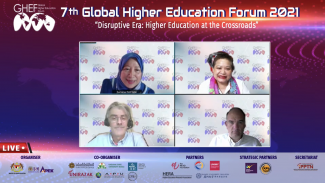
The current era of unprecedented digital transformation demands for higher education institutions to invest in equipping graduates with the skills, competencies, and adaptation to succeed in the tech-driven economy of the future. However, as the COVID-19 pandemic has shown, humanity cannot be overlooked. How can universities strike a balance between providing our graduates with digitalisation skills and, at the same time, human values, resilience, and an enterprising outlook to navigate the unpredictable future of work? This was a key topic discussed at length during the 7th Global Higher Education Forum 2021 (GHEF) held virtually on 16 August 2021.
SMU Associate Provost (Teaching and Learning Innovation) Lieven Demeester, was one of three speakers invited to share insights at a panel discussion, “Nurturing Talent with the Technological and Human Touch Convergence”. The discussion was part of a two-day Forum jointly organised Malaysia’s Ministry of Higher Education (MoHE) and Universiti Sains Malaysia (USM).
SMU’s participation at the GHEF underscored the University’s commitment to its Vision 2025’s strategic priority of “Growth in Asia”. This was in line with the University’s efforts to offer a deep understanding of Asia’s economy, polity and society.
The 1.5 hour-long discourse witnessed an engaging exchange of opinions and experiences between Associate Prof Demeester and fellow panellists, namely University of Portsmouth’s Dean of Digital and Distributed Learning, Prof Alejandro Armellini; and Co-Founder of Dragonfire Corporate Solutions, Ms Hanie Razaif-Bohlender. Universiti Tun Abdul Razak’s Vice-Chancellor, Professor Datin Paduka Dr Samsinar Md. Sidin, moderated the session.
On how universities can seek to balance the development of future talent between technological advancement and human values, Associate Prof Demeester cited SMU’s core curriculum, which is developed around the three pillars of learning - Capabilities, Communities, and Civilisations, as a case in point.
The Capabilities pillar equips students with specific competencies and skills necessary to operate dexterously in an increasingly complex, digitised and data-driven working environment. Courses such as Modes of Thinking, designed with critical thinking and computational thinking as learning outcomes, are inspired by the needs of industry.
“In the two other categories, Communities and Civilisations, these are where we get our students to gain knowledge, to think about it and see how it all comes together,” said Associate Prof Demeester. The Communities pillar gives students an understanding of the economic, technological, and cultural systems and dynamics that structure our interactions with communities, while the Civilisations pillar immerses students in critical dialogues between multiple and competing paradigms of problem-definition and potential solutions to global challenges. “This is one of the main ways we get our students to understand their common humanity and see how that applies in the working world,” he quipped.
Agreeing, Prof Samsinar said that students could better understand the context of knowledge and its application in real-life situations with this form of curriculum. Prof Alejandro remarked that higher education institutions may need to refocus on developing global citizens who are not just skilled but also socially responsible and ethically driven. The panellists discussed the significance of Education 4.0, a purposeful approach to teaching and learning that aligns itself with the emerging fourth industrial revolution and harnesses the potential of digital technologies to transform the future of education.
Offering an industry perspective, Ms Hanie stressed the need for students to gain industry exposure early in their university education in order to appreciate the practical application of their academic studies. She identified Cooperative Education as an educational methodology that combines classroom-based education with practical work experience to illustrate her point.
The panellists also exchanged views on how higher education could leverage lessons from the pandemic, including innovative learning experiences around technological affordances alongside traditional pathways.
As the world recovers from the pandemic, the panel acknowledged that there would be a temptation for educators to revert to pre-pandemic teaching practices. However, the post-pandemic environment for higher education may likely continue to revolve around low physical proximity and low synchronicity in teaching and learning. Prof Alejandro reckoned that “the way to design for effective learning is to redesign” and said that universities ought to move away from the simplistic definition of blended learning as ‘face to face + online learning’, as it is now a much more complex concept.
In line with Prof Alejandro’s opinion, Associate Prof Demeester shared SMU’s experience in changing its teaching practices for students to thrive in an ambidextrous world where they interact both physically and online. The University has also been encouraging faculty to conduct blended learning courses whereby a portion of the semester focuses on asynchronous learning, such as through pre-recorded lectures with complimentary Q&A forums. In this way, learning is augmented, and students can customise learning at their own pace.
Click here for more insights articulated by Prof Demeester and the other GHEF panellists.